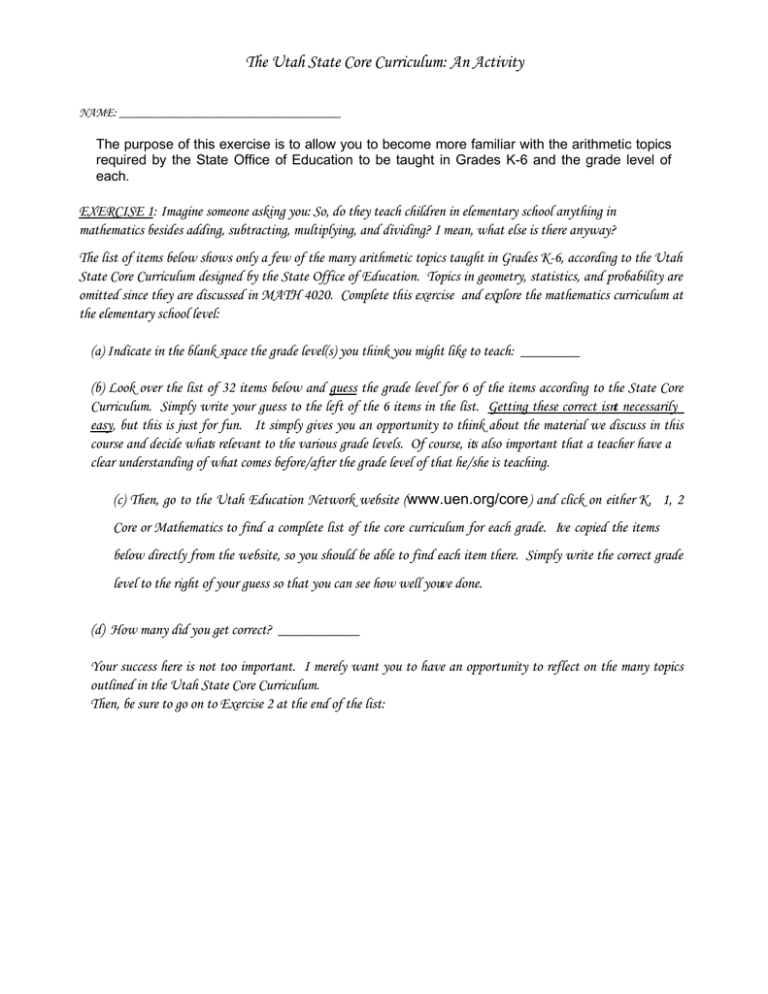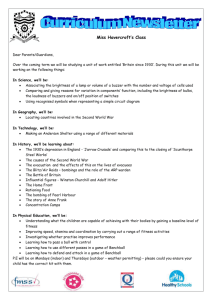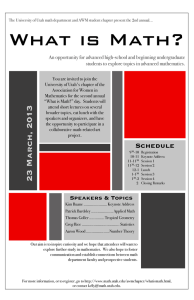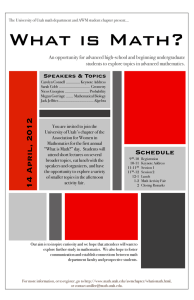The Utah State Core Curriculum: An Activity
advertisement

The Utah State Core Curriculum: An Activity NAME: ____________________________________ The purpose of this exercise is to allow you to become more familiar with the arithmetic topics required by the State Office of Education to be taught in Grades K-6 and the grade level of each. EXERCISE 1: Imagine someone asking you: “So, do they teach children in elementary school anything in mathematics besides adding, subtracting, multiplying, and dividing? I mean, what else is there anyway?” The list of items below shows only a few of the many arithmetic topics taught in Grades K­6, according to the Utah State Core Curriculum designed by the State Office of Education. Topics in geometry, statistics, and probability are omitted since they are discussed in MATH 4020. Complete this exercise and explore the mathematics curriculum at the elementary school level: (a) Indicate in the blank space the grade level(s) you think you might like to teach: ________ (b) Look over the list of 32 items below and guess the grade level for 6 of the items according to the State Core Curriculum. Simply write your guess to the left of the 6 items in the list. Getting these correct isn’t necessarily easy, but this is just for fun. It simply gives you an opportunity to think about the material we discuss in this course and decide what’s relevant to the various grade levels. Of course, it’s also important that a teacher have a clear understanding of what comes before/after the grade level of that he/she is teaching. (c) Then, go to the Utah Education Network website (www.uen.org/core) and click on either “K, 1, 2 Core” or “Mathematics” to find a complete list of the core curriculum for each grade. I’ve copied the items below directly from the website, so you should be able to find each item there. Simply write the correct grade level to the right of your guess so that you can see how well you’ve done. (d) How many did you get correct? ___________ Your success here is not too important. I merely want you to have an opportunity to reflect on the many topics outlined in the Utah State Core Curriculum. Then, be sure to go on to Exercise 2 at the end of the list: A Sampling of Items from the Utah State Core Curriculum for Mathematics: 1. Order a set of up to ten objects and use ordinal numbers from first to tenth to identify the position of the object in the chosen order. 2. Identify and describe simple repeating patterns with numbers and shapes. 3. Demonstrate the joining and separating of sets with objects to solve problems. 4. Estimate quantities in a set of objects using multiples of 10 as benchmark numbers. 5. Use properties of addition (commutative, associative, identity element) and the mathematical relationship between addition and subtraction to solve problems. 6. Recognize that “+ ” indicates joining to two sets and that “­ “ indicates the separation of two sets. 7. Write and solve number sentences from problem situations involving addition and subtraction, using symbolic notation for the missing value (e.g., D + 4 = 7 ). 8. Sort and classify objects using more than one attribute. 9. Represent the unit fractions 1 2 , 1 3 , and 1 4 with objects, pictures, words (e.g., ___ out of ___ equal parts), and symbols. 10. Write a story problem that relates to a given addition or subtraction equation, and write a number sentence to solve a story problem that is related to the environment. 11. Represent division as fair shares using concrete objects or pictures. 12. Demonstrate quick recall of addition facts (up to 10+10) and related subtraction facts. 13. Order and compare whole numbers on a number line and use the inequality symbols <, >, ≠, and = when comparing whole numbers. 14. Identify factors and multiples of whole numbers. 15. Demonstrate the meaning of multiplication and division of whole numbers through the use of a variety of representations (e.g., equal­sized groups, arrays, area models, and equal jumps on the number line for multiplication, partitioning and sharing for division). 16. Find the sum or difference of numbers, including monetary amounts, using models and strategies such as expanded form, compensation, partial sums, and the standard algorithm. 17. Identify and number that is between two given numbers (e.g., 3.2 is between 3 and 4; find a number between 0.1 and 0.2). 18. Select and write a multiplication or division sentence to solve a problem related to the students’ environment and write a story problem that relates to a given sentence. 19. Represent division of a three­digit dividend by a one­digit divisor, including whole number remainders,using a variety of methods (e.g., rectangular arrays, manipulatives, pictures), and connect the representations to an algorithm. 20. Add and subtract decimals and simple fractions where one single­digit denominator is 1,2,3 times the other (e.g., 2 4 +1 4 = 3 4 ; 1 3 -1 6 = 1 6 ). 21. Represent repeated factors using exponents. 22. Rewrite mixed numbers and improper fractions from one form to the other and represent each using regions, sets of objects, or line segments.. 23. Find common multiples and factors, and apply to adding and subtracting fractions. 24. Divide multi­digit dividends by a one­digit divisor with fluency, using efficient procedures. 25. Add and subtract fractions with fluency. 26. Use patterns, models, and relationships as contexts for writing and solving simple equations and inequalities with whole number solutions (e.g., 6x = 54; x +3 = 7 ). 27. Represent repeated factors using exponents. 28. Find the prime factorization of composite numbers to 100. 29. Give mixed number and decimal solutions to division problems with whole numbers. 30. Relate percents less than 1% or greater than 100% to equivalent fractions, decimals, whole and mixed numbers. 31. Draw a graph and write an equation from a table of values. 32. Solve single variable linear equations using a variety of strategies. EXERCISE 2: Find 6 additional mathematics­related items from the website for the grade level(s) that you’d like to teach. Based on your own experiences, write down which of these items you may not understand or feel the most in need of review. (1) __________________________________________________________________________________ (2) __________________________________________________________________________________ (3) __________________________________________________________________________________ (4) __________________________________________________________________________________ (5) __________________________________________________________________________________ (6) __________________________________________________________________________________



